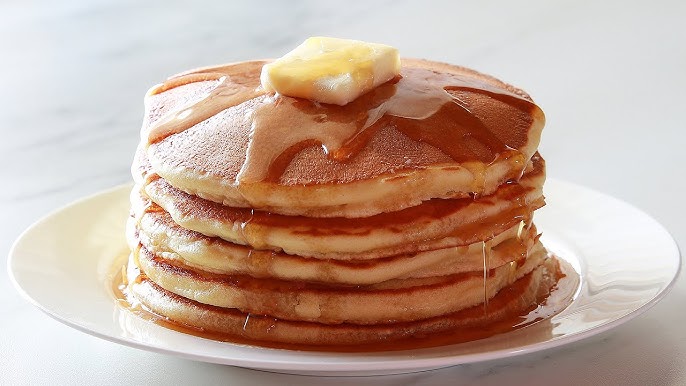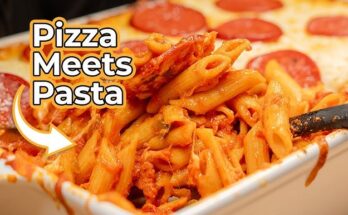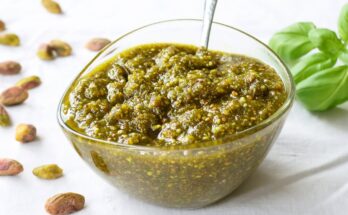Best Fluffy Pancake Recipe: Who doesn’t love pancakes for breakfast, especially when they’re melt-in-your-mouth fluffy and golden? Whether it’s a lazy Sunday or you’re whipping up a special brunch, nothing says comfort food like a tall stack of fluffy pancakes. These heavenly rounds of deliciousness can brighten anyone’s morning and become the highlight of your weekend routine.
But let’s face it—nailing the perfect pancake texture can feel like a mini science experiment. If you’ve ever ended up with flat, rubbery, or overly dense pancakes, you’re not alone. The key to fluffy pancakes lies in the science of your ingredients and the method of preparation.
In this detailed, step-by-step guide, we’re diving deep into how you can make the best fluffy pancakes right at home. No fancy tools, no complicated techniques—just tried-and-tested steps to get you those diner-style pancakes that are crispy on the edges and super soft in the middle.
Ingredients You’ll Need
The ingredients for fluffy pancakes are pretty basic, but it’s the quality and balance that makes all the difference. Here’s what you’ll need:
Essential Ingredients:
- 1 ½ cups all-purpose flour
- 3 ½ tsp baking powder
- 1 tbsp sugar (you can adjust for sweetness)
- ¼ tsp salt
- 1 ¼ cups milk (whole milk preferred)
- 1 egg
- 3 tbsp melted butter (unsalted)
- 1 tsp vanilla extract (optional but recommended)
Optional Add-ins:
- A pinch of cinnamon or nutmeg for warmth
- Chocolate chips, blueberries, or banana slices
- A splash of buttermilk for a tangy twist
The baking powder is your pancake’s best friend here. It’s what creates that airy lift, helping your pancakes puff up to fluffy perfection. And if you want an even richer taste, swapping some of the milk with buttermilk can work wonders.
Tools You’ll Need
You don’t need a lot of fancy gadgets, but having the right tools makes things smoother:
- Mixing bowls (one large, one medium)
- A whisk or fork for mixing
- Measuring cups and spoons
- Non-stick frying pan or griddle
- Spatula
- Ladle or measuring cup for pouring batter
Using a non-stick pan or griddle helps achieve that golden brown surface without sticking, and a silicone spatula makes flipping easy and damage-free.
Step-by-Step Instructions
Step 1: Preparing the Dry Ingredients
In a large bowl, sift together the flour, baking powder, sugar, and salt. Sifting helps break up clumps and aerates the flour, which contributes to a lighter batter. Mix them gently using a whisk to ensure even distribution.
Step 2: Mixing the Wet Ingredients
In a separate bowl, whisk together the milk, egg, melted butter, and vanilla extract. Make sure the melted butter has cooled slightly so it doesn’t scramble the egg. This step is key in creating a smooth, lump-free mixture that blends seamlessly with the dry ingredients.
Step 3: Combining Wet and Dry Ingredients
Make a well in the center of your dry mix and slowly pour in the wet mixture. Stir everything together gently—don’t overmix. A few small lumps are perfectly fine and actually help in achieving fluffier pancakes. Overmixing activates the gluten in the flour, which can make your pancakes tough.
Step 4: Heating the Pan Correctly
Preheat your non-stick pan or griddle over medium heat. To test if it’s ready, flick a few drops of water onto the surface. If they sizzle and dance, your pan is ready. Lightly grease with butter or oil, then wipe off the excess with a paper towel.
Step 5: Cooking the Pancakes
Using a ladle or measuring cup, pour the batter onto the heated pan. Cook each side for about 2–3 minutes. You’ll know it’s time to flip when bubbles form on the surface and the edges look slightly set. Flip gently and cook for another 2 minutes or until golden brown.
Keep cooked pancakes warm in a low oven while you finish the rest. Don’t stack them directly, as the steam can make them soggy.
Pro Tips for Fluffy Pancakes
Fluffy pancakes don’t just happen by chance—they’re the result of smart techniques and attention to detail. Here are some tips that can turn your good pancakes into great ones:
- Don’t Overmix the Batter
This is probably the most common mistake. Stirring your batter too much will over-activate the gluten in the flour, resulting in tough, chewy pancakes. Mix just until the ingredients are combined—lumps are your friend here! - Let the Batter Rest
Once mixed, let the batter rest for 5–10 minutes. This short pause allows the flour to fully absorb the liquid, thickening the batter slightly and giving the baking powder time to start working its magic. - Use Buttermilk or Yogurt
Substituting some of the milk with buttermilk or plain yogurt adds a pleasant tanginess and reacts better with baking soda, creating more rise. It also helps achieve that tender, melt-in-your-mouth texture. - Avoid Pressing Down with the Spatula
When cooking the pancakes, resist the urge to flatten them with your spatula. Pressing down will squeeze out the air bubbles, making them less fluffy. - Cook on Medium-Low Heat
High heat might brown the outside too quickly while leaving the inside undercooked. A steady medium-low heat ensures they cook evenly and thoroughly, allowing them to rise beautifully. - Use Fresh Baking Powder
Old or expired baking powder won’t give you that fluffy lift. If in doubt, test it by adding a teaspoon to hot water—if it fizzes, it’s still good.
Common Mistakes to Avoid
Even seasoned pancake makers can run into issues. Avoid these traps to keep your pancakes light and airy:
- Using Cold Ingredients: If your milk or egg is straight from the fridge, it can seize the melted butter when mixed. Let your wet ingredients come to room temperature before mixing.
- Too Much Liquid: A runny batter makes thin pancakes. You want a slightly thick, pourable batter—not soupy.
- Skipping the Rest Period: As tempting as it is to get straight to cooking, skipping the batter rest time can lead to flat, dense pancakes.
- Using the Wrong Pan: A heavy-bottomed, non-stick skillet or griddle gives you the best heat distribution. Thin pans often cause uneven browning.
- Cooking on High Heat: This will give you pancakes that are burnt outside and raw inside. Slow and steady wins the race here.
Serving Suggestions
You’ve made the perfect stack—now it’s time to top it like a pro. Here are some tasty ways to serve your fluffy pancakes:
Classic Options:
- A pat of butter and a generous drizzle of maple syrup
- Fresh fruit like strawberries, blueberries, or banana slices
- A dusting of powdered sugar
Creative Combos:
- Peanut butter and banana with a touch of honey
- Greek yogurt, granola, and a spoonful of berry compote
- Whipped cream, Nutella, and chopped hazelnuts
- Lemon zest with a drizzle of honey and thyme
Savory Variants: If you’re in the mood for something different, try topping your pancakes with crispy bacon, a fried egg, and a dash of hot sauce for a savory twist.
Pancake Bar Idea: Hosting a brunch? Set up a DIY pancake bar with various toppings—think syrups, fruits, spreads, and nuts—so guests can customize their stacks.
Storage and Reheating Tips
Don’t let leftover pancakes go to waste! Here’s how to keep them fresh and delicious:
Storing in the Fridge:
- Let pancakes cool completely
- Stack them with a piece of parchment paper between each one
- Store in an airtight container for up to 3 days
Freezing for Later:
- Follow the same steps as above
- Place in a zip-top freezer bag
- Freeze for up to 2 months
Reheating Pancakes:
- Microwave: Wrap in a damp paper towel and heat for 20–30 seconds
- Oven: Place on a baking sheet, cover with foil, and bake at 350°F for 10 minutes
- Toaster: Toast them lightly for a crispier texture
Nutritional Information
Understanding what’s on your plate is just as important as enjoying it. Here’s a general breakdown of the nutrition in a basic fluffy pancake serving (2 medium pancakes, plain, without toppings):
| Nutrient | Amount Per Serving |
|---|---|
| Calories | 210–250 kcal |
| Carbohydrates | 30–35g |
| Protein | 5–7g |
| Fat | 8–10g |
| Saturated Fat | 3–5g |
| Fiber | 1–2g |
| Sugar | 4–6g |
| Sodium | 300–400mg |
Keep in mind, the numbers can vary depending on the ingredients you use—whole milk vs. plant-based, added sugars, or toppings like butter and syrup can significantly alter the calorie and sugar content.
If you’re trying to make your pancakes healthier, you can:
- Substitute half the flour with whole wheat flour
- Use plant-based milk like almond or oat
- Replace butter with mashed banana or unsweetened applesauce
- Use natural sweeteners like honey or maple syrup in moderation
Conclusion
There’s something so nostalgic and comforting about a stack of fluffy pancakes. They’re not just a meal—they’re a weekend tradition, a cozy breakfast-in-bed option, or a fun treat for kids and adults alike. And when you make them from scratch, you know exactly what’s going into them.
The beauty of this recipe is that it’s foolproof. By following the simple steps, paying attention to the little things—like letting your batter rest or not overmixing—you’ll master the art of fluffy pancakes in no time. Whether you enjoy them with classic maple syrup or go wild with creative toppings, these pancakes are sure to become a staple in your breakfast rotation.
So next time you’re craving a warm, buttery, cloud-like bite, you know what to do. Grab those ingredients, heat up the pan, and flip your way to pancake heaven.



